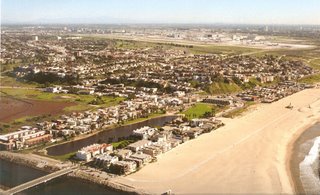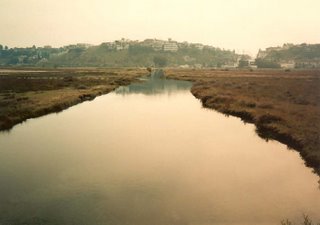TOE’S BEACH
DUNES AT SOUTHWEST END OF DEL REY LAGOON PARK AND FRONTING ON THE BEACH: APPROX. 2 ACRES. LOCATED IMMEDIATELY WEST OF BASEBALL FIELDS. ALSO, A SMALL CITY-OWNED
HABITAT VALUE:
NATIVE PLANTS:
beach evening primrose (camissonia cheiranthifolia, subspecies suffrutescens)
-------------------------------------------------
Sea rocket (cakile maritime)
http://images.google.com/images?svnum=10&hl=en&lr=&q=cakile+maritima
-------------------------------------------------
dune ragweed or silver beach-bur (ambrosia chamissonis)
-------------------------------------------------
saltgrass (distichlis spicata)
http://images.google.com/images?q=distichlis+spicata&hl=en
-------------------------------------------------
telegraph weed (heterotheca grandiflora)
-------------------------------------------------
beach or pink sand verbena (abronia umbellata)
---------------------------------------------------------
beach morning glory (calystegia soldanella)
http://images.google.com/images?q=calystegia+soldanella&hl=en&btnG=Search+Images
DEL REY
NORTH END OF DEL REY LAGOON PARK: APPROX. 2 ACRES
HABITAT VALUE: Historical maps show Del Rey Lagoon as the historic mouth of the Ballona Creek. Increasing the ecological value of this site will require better connection with Ballona Creek, through Lot C, which is currently threatened with development. This site would have a high value as part of a larger rehabilitation of the Del Rey Lagoon to increase/establish tidal flushing and replace the largely exotic landscaping with native species. This would enhance foraging opportunities for the endangered California Least Tern. Lot C is the ideal location for such an effort, so that restoration occurs at the northern end of the lagoon, leaving existing recreational uses intact at the southern end.
NATIVE PLANTS:
telegraph weed (heterotheca grandiflora)
-------------------------------------------------
seaside heliotrope or sand heliotrope (heliotropium curassavicum, variety oculatum)
-------------------------------------------------
Spurge
-------------------------------------------------
saltgrass (distichlis spicata)
http://images.google.com/images?q=distichlis+spicata&hl=en
-------------------------------------------------
pickleweed (salicornia virginica)
-------------------------------------------------
Coyote brush (baccharis pilularis, subspecies consanguinea)
-------------------------------------------------
Wild cucumber (marah macrocarpus)
http://images.google.com/images?svnum=10&hl=en&lr=&q=marah+macrocarpus&btnG=Search
EL SEGUNDO SAND DUNES—REPLANTED AREA ALONG
THIS PROPERTY IS OWNED BY THE L.A. DEPARTMENT OF AIRPORTS AND FORMERLY WAS DEVELOPED WITH HOMES THAT WERE REMOVED BY THE AIRPORT DEPT. IN THE 1970’S.
THE STREETS WERE NOT REMOVED AND ARE VISIBLE IN THE ABOVE PHOTOGRAPH IN THE UPPER-RIGHT-HAND CORNER.
THE ENTIRE SITE IS CLOSED TO THE PUBLIC, EXCEPT FOR A NARROW LANDSCAPED STRIP ALONG THE NORTH END FRONTING
HABITAT VALUE: At 300 acres, the dunes at LAX represent an internationally significant biodiversity hotspot. Many unique subspecies are found on the dunes, including the El Segundo dunes spineflower, El Segundo blue butterfly, four unique moths, a new species of crab spider, two rare weevil species, and the unique El Segundo dunes
NATIVE PLANTS OF THE STRIP ALONG
coastal sagebrush or
-------------------------------------------------
telegraph weed (heterotheca grandiflora)
-------------------------------------------------
silver dune bush lupine (lupinus chamissonis)
-------------------------------------------------
beach evening primrose (camissonia cheiranthifolia, subspecies suffrutescens)
-------------------------------------------------
deerweed, lotus scoparius,
http://images.google.com/images?svnum=10&hl=en&lr=&q=lotus+scoparius
-------------------------------------------------
Sea rocket (cakile maritime)
http://images.google.com/images?svnum=10&hl=en&lr=&q=cakile+maritima
-------------------------------------------------
Plant that is either Horseweed or Artemisia dracunculus:
Mugwort also called wild tarragon or dragon sagewort (artemisia dracunculus)
horseweed (conyza canadensis)
-------------------------------------------------
croton (croton Californicus)
-------------------------------------------------
wild heliotrope (phacelia ramosissima, variety austrolitoralis) (likely)
-------------------------------------------------
beach or pink sand verbena (abronia umbellata)
-------------------------------------------------
California poppy (eschscholzia Californica)
-------------------------------------------------
dune ragweed or silver beach-bur (ambrosia chamissonis)
-------------------------------------------------
Gnaphalium (species ?)
-------------------------------------------------
Coast goldenbush, (isocoma menziesii)
http://images.google.com/images?q=Isocoma+menziesii&hl=en&btnG=Search+Images
-------------------------------------------------
Lupine (yellow flowered)
-------------------------------------------------
jimson weed or tolguacha (datura wrightii or datura meteloides)
http://images.google.com/images?svnum=10&hl=en&lr=&q=datura+wrightii+
-------------------------------------------------
western ragweed (ambrosia psilostachya, subspecies Californica)
http://images.google.com/images?q=ambrosia+psilostachya&hl=en
suffrutescent wallflower (erysimum suffrutescens)
-------------------------------------------------
yellow pincushion (chaenactis glabriuscula, variety tenuifolia)
http://images.google.com/images?svnum=10&hl=en&lr=&q=chaenactis+glabriuscula&btnG=Search
-------------------------------------------------
-------------------------------------------------
Bush sunflower (encelia californica)
http://images.google.com/images?q=encelia+californica&hl=en&btnG=Search+Images
BLUFF FACE BETWEEN SINALOA AND NICHOLSON
(LOCATION IN ABOVE PHOTO: MIDDLE, TO EAST OF BASEBALL FIELD)
in addition to approximately 43 acres of the bluff top, bluff face and wetlands that is owned by the Southern California Gas Company and is used to store natural gas underground, there is a section of the bluff face that faces an immediate threat of development. This area is small in size, 1.5 acres, but is visually huge as it is right at the western gateway to the Ballona Wetlands and is the proposed site of 18 homes. This land is bounded by the State-owned wetlands and the unpaved
This site consists of 18 small residential-zoned lots that are on the steep upslope of the sand dune from Cabora Rd. Cabora is a narrow unpaved path starting just up the hill from the intersection of
A proposal was made to develop the lots in 2005, however, we have heard of no further progress on the proposal since then.
NATIVE PLANTS:
Coyote brush (baccharis pilularis, subspecies consanguinea)
-------------------------------------------------
Herb, looks like chenopodium
-------------------------------------------------
Gnaphalium (species?)
-------------------------------------------------
deerweed, lotus scoparius,
http://images.google.com/images?svnum=10&hl=en&lr=&q=lotus+scoparius
-------------------------------------------------
croton (croton Californicus)
-------------------------------------------------
cudweed (gnaphalium Californicum “Calif. Everlasting”,
-------------------------------------------------
California poppy (eschscholzia Californica)



No comments:
Post a Comment